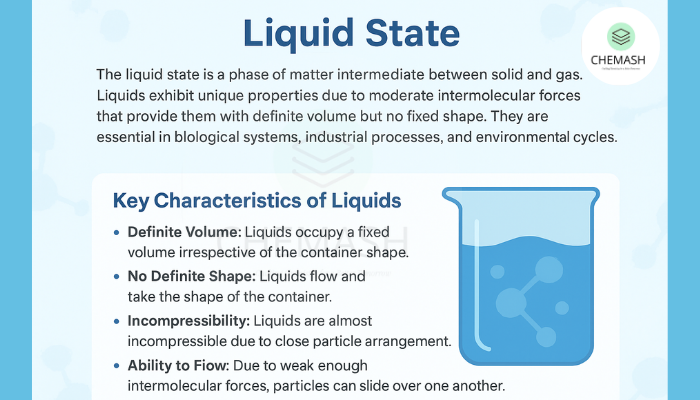
Liquid State
The liquid state is a phase of matter intermediate between solid and gas. Liquids exhibit unique properties due to moderate intermolecular forces that provide them with definite volume but no fixed shape. They are essential in biological systems, industrial processes, and environmental cycles.
Key Characteristics of Liquids
- Definite Volume: Liquids occupy a fixed volume irrespective of the container shape.
- No Definite Shape: Liquids flow and take the shape of the container.
- Incompressibility: Liquids are almost incompressible due to close particle arrangement.
- Ability to Flow: Due to weak enough intermolecular forces, particles can slide over one another.
Intermolecular Forces in Liquids
Liquids have stronger intermolecular forces than gases but weaker than solids. These forces include:
- Hydrogen bonding (e.g., water, alcohols)
- Dipole-dipole interactions (e.g., acetone, HCl)
- London dispersion forces (e.g., noble gas liquids like liquid xenon)
Physical Properties of Liquids
The behavior and uses of liquids are explained by the following physical properties:
| Property | Description | Example |
|---|---|---|
| Viscosity | Resistance to flow | Honey > Water |
| Surface Tension | Resistance to increase in surface area | Water drops on wax |
| Vapor Pressure | Pressure of vapor in equilibrium with liquid | Alcohol > Water |
| Boiling Point | Temp. at which vapor pressure = atmospheric pressure | Water: 100°C |
Evaporation & Boiling
Evaporation is the process of a liquid turning into vapor at temperatures below its boiling point. It is a surface phenomenon. In contrast, boiling occurs throughout the bulk of the liquid once vapor pressure equals atmospheric pressure.
Factors affecting evaporation:
- Surface area (↑ area = ↑ evaporation)
- Temperature (↑ temp = ↑ evaporation)
- Humidity (↑ humidity = ↓ evaporation)
Quiz – Liquid State
- Which of the following liquids has the highest viscosity?
a) Water
b) Acetone
c) Honey
d) Alcohol
Answer: c)
Explanation: Honey has strong intermolecular attractions, leading to higher resistance to flow. - Boiling point of a liquid increases with:
a) Decrease in vapor pressure
b) Increase in vapor pressure
c) Increase in temperature only
d) Decrease in atmospheric pressure
Answer: a)
Explanation: Lower vapor pressure means more energy (higher temp) is needed to match atmospheric pressure. - Evaporation is a:
a) Bulk phenomenon
b) Surface phenomenon
c) Instantaneous reaction
d) Only happens at boiling point
Answer: b)
Explanation: Evaporation only occurs at the surface and does not require the boiling point to be reached. - Surface tension is due to:
a) Gravitational pull
b) Adhesion
c) Cohesive forces
d) Capillary action
Answer: c)
Explanation: Cohesive forces between molecules at the surface create tension resisting expansion.
FAQ — Quick Answers
Q: Why do liquids have definite volume but no fixed shape?
A: Because of moderate intermolecular forces — they hold volume constant but allow particles to slide, so liquids take the container’s shape.
Q: How does temperature affect viscosity?
A: Higher temperature decreases viscosity by reducing intermolecular forces. Learn more.
Q: What is the difference between evaporation and boiling?
A: Evaporation is a surface process below boiling point, while boiling happens throughout the liquid when vapor pressure = atmospheric pressure. More detail.
Q: What causes surface tension?
A: Cohesive forces between molecules at the surface create resistance to expansion. Wikipedia.
- Liquid — Wikipedia
- Liquid State — Britannica
- Surface tension & detergents — Sciencing
- Next: Properties of Gases (CHEMASH internal)
- Back to: States of Matter (CHEMASH internal)
Published by CHEMASH — last updated: Oct 2, 2025
